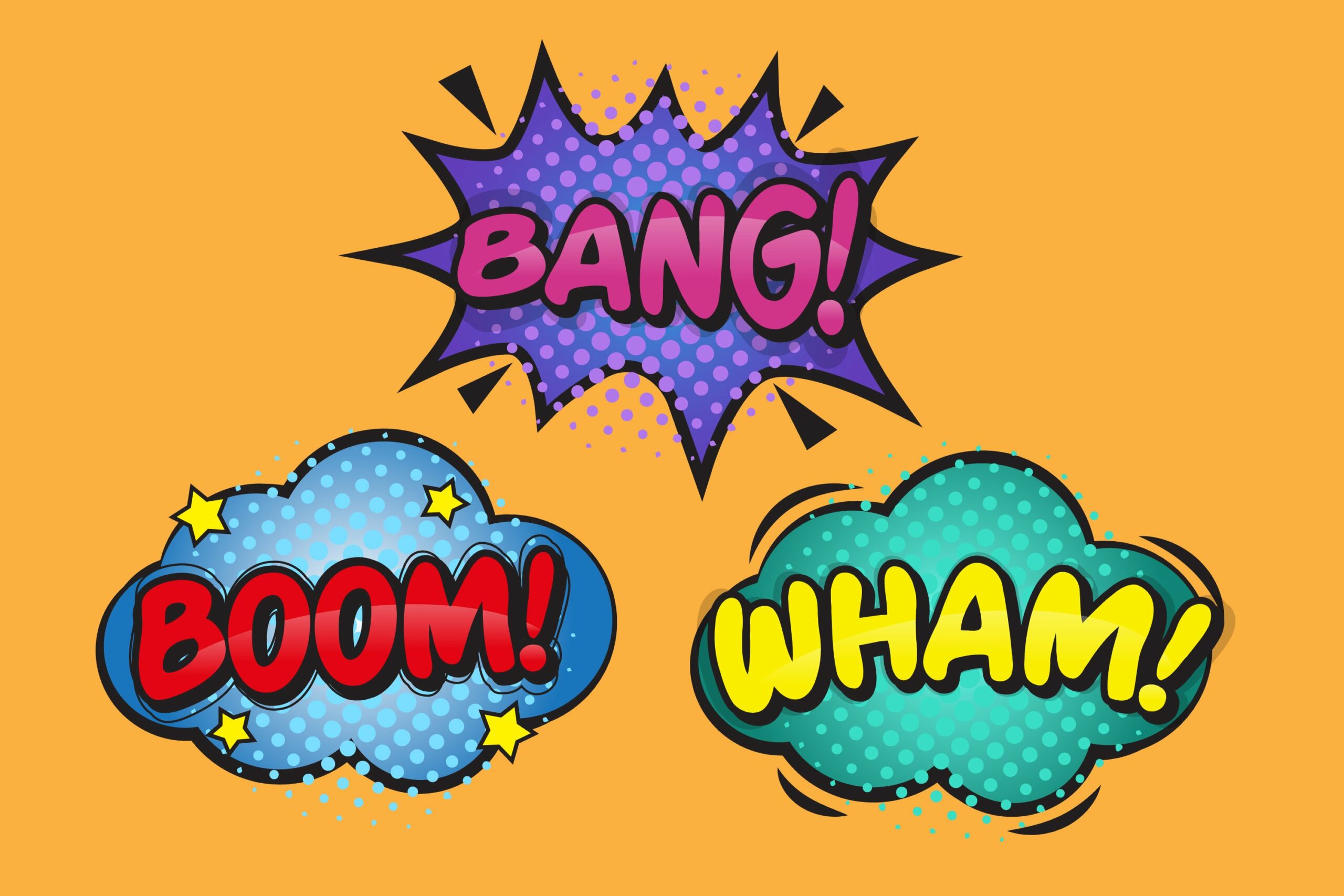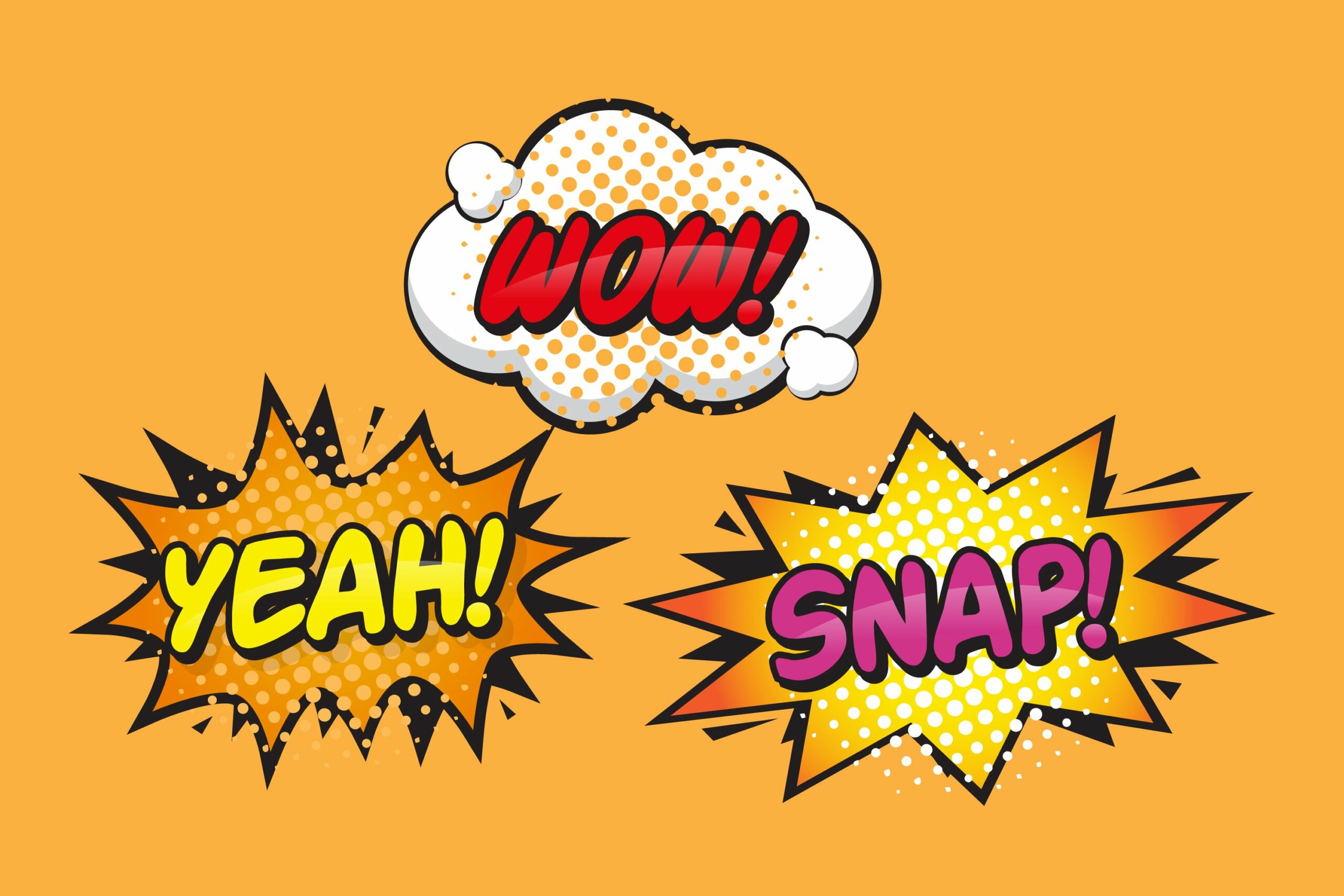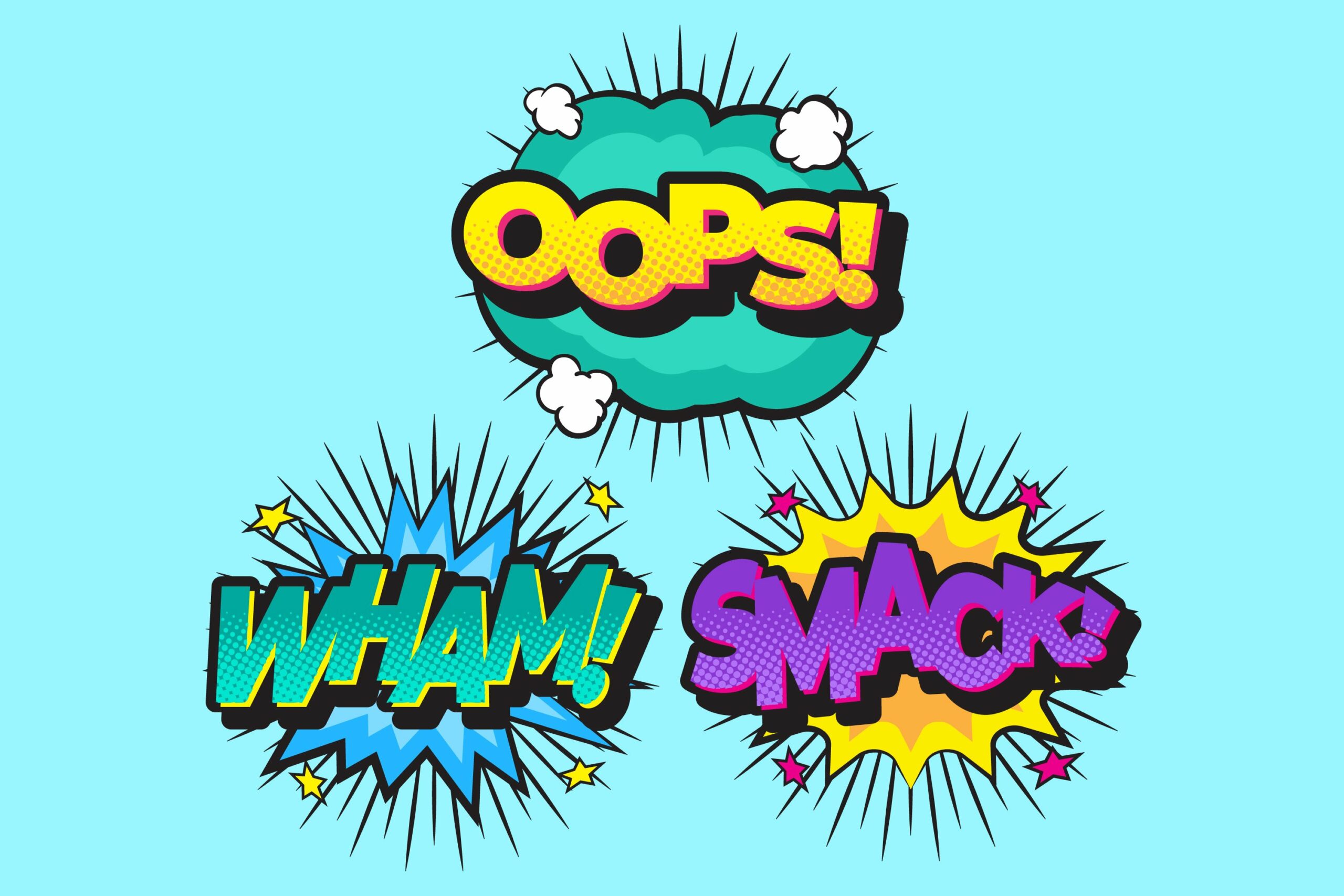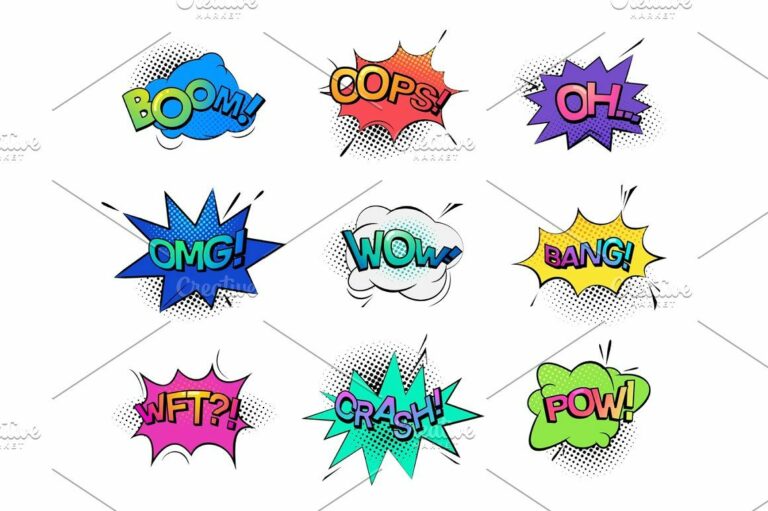Are you a fan of comics and wondering what those sound effects are called? Look no further! In this post, we will explore the different terms used to describe the various sounds in comics. From onomatopoeia to sound bubbles, we will cover it all. Whether you’re curious about the exclamations or text bubbles, this post will provide you with all the information you need. So, let’s dive in and discover the fascinating world of sound effects in comics!
Exploring the Vocabulary of Sound Effects in Comics
Onomatopoeia is a literary device where a word imitates or suggests the sound that it describes. In comics, onomatopoeia is an essential aspect that represents sound effects. It is a visual representation of a sound that can make the comic panels come alive. The use of onomatopoeia in comics enables readers to experience the action in the story, creating a more immersive experience.
Onomatopoeic words are often used in comics to represent sounds such as explosions, gunshots, and punches, among others. For example, the sound of a gun firing can be represented by the word “bang,” and the sound of a punch can be represented by the word “pow.” Other examples of onomatopoeia used in comics include “boom,” “crash,” “thud,” and “sizzle.” The use of these words enhances the visual and auditory experience of the comic, making it more engaging for the reader.
In short, onomatopoeia is an essential aspect of comics that helps to bring the story to life. It is a literary device that enables the reader to visualize and hear the sounds in the story. The use of onomatopoeia in comics is an effective way to engage the reader and make the comic more exciting and immersive.

🍿 Must Read What is music at the end of a show called?
Exploring the Use of Sound Words in Comics: Learn All About Them!
In comic books, sound effects or sound words are often used to add a new dimension to the visuals. These words are known as onomatopoeia, which is derived from Greek words that mean “name” and “I make”. Onomatopoeic words are those that sound like the thing they are describing. In comics, they are used to describe sounds that are part of the story, such as the sound of a gunshot, a car horn, or a door slamming shut.
These sound effects are usually written in bold letters, often with jagged edges, to emphasize the suddenness and loudness of the sound. They are usually placed close to the object that is making the sound, so that readers can easily connect the sound with the action. Some examples of onomatopoeic words that are commonly used in comics include “bang,” “thud,” “crash,” “buzz,” and “click.”
Sound effects in comics are a powerful tool that can help to create a more immersive experience for readers. They can help to convey the intensity and emotion of a scene, and add an extra layer of meaning to the visuals. When used effectively, they can make a comic book come alive, and transport readers into the world of the story.
Understanding Sound in Comics: The Importance of Sound Effects.
In the world of comics, sound effects play a crucial role in creating a dynamic and immersive experience for readers. A sound effect, also known as onomatopoeia, is a word that represents a sound and is spelled to reflect the sound it represents. For instance, “bang,” “pow,” “zap,” and “thud” are all examples of onomatopoeia that are commonly used in comics.
Onomatopoeic words in comics typically serve to enhance the visual storytelling by adding an extra layer of sensory experience. These words can be used to convey the sounds of actions, such as a punch or a gunshot, or the sounds of objects, such as a car engine or a bird chirping.
Similar to music, the choice of onomatopoeic words in comics is carefully selected to complement the character and setting of the story. For example, the sound effects used in a superhero comic may differ from those used in a horror comic. In addition, the style and design of the lettering used for the sound effects can also vary, depending on the tone and mood of the scene.
Overall, sound effects are an integral part of the comic book medium, and they can add a dynamic and immersive element to the visual storytelling.

Discovering the Name for Exclamations Used in Comics
Exclamations in comics are referred to as grawlixes. Grawlixes are essentially a group of typographical symbols used in comics to indicate that a character is swearing or expressing strong emotions such as anger or surprise. The term “grawlix” was coined by American cartoonist Mort Walker in the 1960s, and it has since become a popular term used in the world of comics.
Grawlixes are often used in place of actual profanity to maintain a comic’s family-friendly status. They can take many forms, including a series of symbols such as asterisks, hashtags, or at signs, arranged in a way that suggests a curse word. For example, a grawlix might look like “!@#$%!” or “#$%@!”
The use of grawlixes is not limited to exclamations of surprise or anger. They can also be used to represent other sounds, such as the sound of a car engine or a gunshot. In these instances, they are referred to as sound effects.
In summary, grawlixes are a type of typographical symbol used in comics to indicate strong emotions or sounds. They are often used in place of profanity to maintain a comic’s family-friendly status, and the term “grawlix” was coined by Mort Walker in the 1960s.
>> Related – What issue is Batman: Death in the Family comic?
The Terminology for Sound Effects in Cartoons Explained
In any cartoon or animation, sound effects play a crucial role in bringing the world and its characters to life. They help to create a sense of realism and immerse the viewers into the story. The foley department is responsible for creating these sound effects, which include everything from footsteps to the sound of objects being touched or moved. These sound effects are commonly referred to as “props” and are an integral part of the animation process.
The foley department uses various techniques to create these sound effects. They may use everyday objects such as keys, cans, or even shoes to create unique sounds that match the action on screen. They also use specialized equipment such as microphones and sound mixers to capture and manipulate the sounds. By layering different sounds together, they can create complex and realistic soundscapes.
One of the key benefits of using sound effects is that they can help to convey emotion and mood. For example, a sudden loud noise can create a sense of tension or surprise, while a soft and subtle sound can create a feeling of calmness or serenity. In addition, sound effects can also be used to help establish the setting of a scene. For example, the sound of birds chirping in the background can indicate that a scene is taking place in a park or forest.
Overall, sound effects are an essential component of any cartoon or animation. They help to bring the world and its characters to life and create a sense of immersion for the viewers. The foley department’s expertise in recording and manipulating sound allows them to create unique and memorable soundscapes that enhance the storytelling experience.
Understanding the Speech Balloons in Comics.
Speech balloons or speech bubbles are an essential part of comics, cartoons, and other graphic narratives. They are the visual representation of a character’s speech or thoughts in a comic book. Speech balloons are also known as dialogue balloons, word balloons, or simply balloons. They are a graphic convention used to convey the words of a character in a comic strip or cartoon.
Speech balloons come in different shapes and sizes, and their placement depends on the layout and design of the comic. They can be round, oval, cloud-shaped, or even jagged to depict shouting or anger. The tail of the balloon points towards the character who is speaking, indicating who is saying what.
Speech balloons can also be used to convey other sounds and noises, such as laughter, gasps, or sighs. These are commonly referred to as sound effects or sound words in comics. The use of sound effects in comics is an essential part of the storytelling process, as it helps the reader understand the emotions and actions of the characters.
In summary, speech balloons are a crucial element in comics, cartoons, and graphic novels, and they serve to convey the words and thoughts of the characters. They come in different shapes and sizes, and their placement depends on the comic’s layout and design. Sound effects or sound words are also commonly used in comics to convey various sounds and noises.

Unraveling the Mystery: The Name of those Speech Bubbles in Comics.
In comics, text bubbles are the primary way that characters communicate with each other. These speech bubbles are also commonly known as speech balloons. Each speech bubble has a tail that points to the speaker, indicating who is saying what. This tail serves as a visual cue for the reader, helping them to understand the flow of conversation between characters.
The speech bubble itself is made up of several different parts. The first is the border, which is the outline of the speech bubble. This can be different shapes depending on the style of the comic or the mood of the scene. The second part is the tail or pointer, which connects the border to the speaker. The tail can be straight or curved, depending on the direction of the speech bubble.
Inside the speech bubble is the text, which is what the character is saying. The text is often written in a specific font to differentiate it from the rest of the comic’s text. In addition, the text can be enclosed in a special shape to indicate different emotions or sounds. For example, a jagged border can indicate shouting, while a cloud shape can indicate a thought bubble.
Speech bubbles are a crucial part of comics, as they allow characters to communicate with each other and the reader. They are also an important tool for conveying information and setting the tone of a scene. Understanding the different parts of a speech bubble can help readers to better understand the story and follow the conversation between characters.
The Sound Effects in Comic Books: Exploring Onomatopoeia.
While Onomatopoeia may be a well-known supervillain in the DC Comics universe, the term onomatopoeia itself has a different meaning in the comic book world. Onomatopoeia in comic books refers to the use of words that imitate the sounds they describe. These words are often used to depict sound effects, such as a “bang” or “boom” during a fight scene or the “whoosh” of a superhero’s cape as they fly through the air.
The use of onomatopoeia in comic books can be traced back to the early days of the medium, with creators using hand-lettered sound effects to add an extra dimension of excitement to their stories. Over time, these sound effects became more sophisticated, with different fonts and styles used to convey the tone and intensity of the sound being depicted.
In addition to sound effects, onomatopoeia can also be used to convey the way characters speak. For example, a character with a deep voice might have their dialogue lettered in a bold, heavy font, while a character with a high-pitched voice might have their dialogue in a lighter, more delicate font.
Overall, onomatopoeia is an essential component of comic book storytelling, helping to create a vivid and immersive world for readers to explore. Whether it’s the sound of a superhero’s punch landing on a villain or the sound of a car screeching to a halt, onomatopoeia brings comic book stories to life in a way that no other medium can match.
More to discover
the use of onomatopoeia in comics is an essential aspect of conveying sound effects. Whether it’s a “Pow!” or a “Bang!”, sound words in comics play a significant role in enhancing the reader’s experience. The sound bubbles, text bubbles, and exclamations are all essential elements that add to the overall appeal of comics. So, the next time you read a comic book, pay attention to the sound effects and appreciate the creativity behind them.
